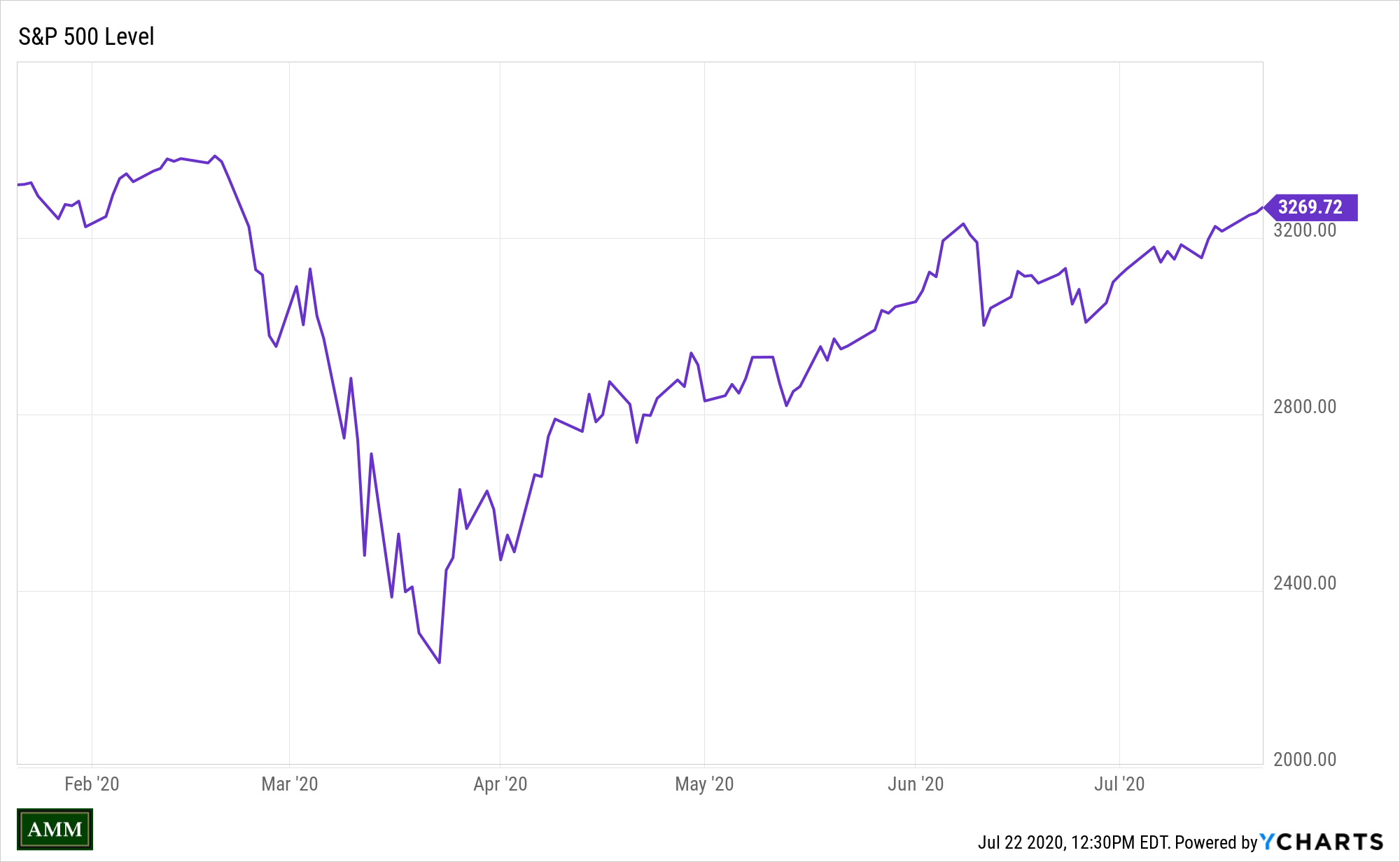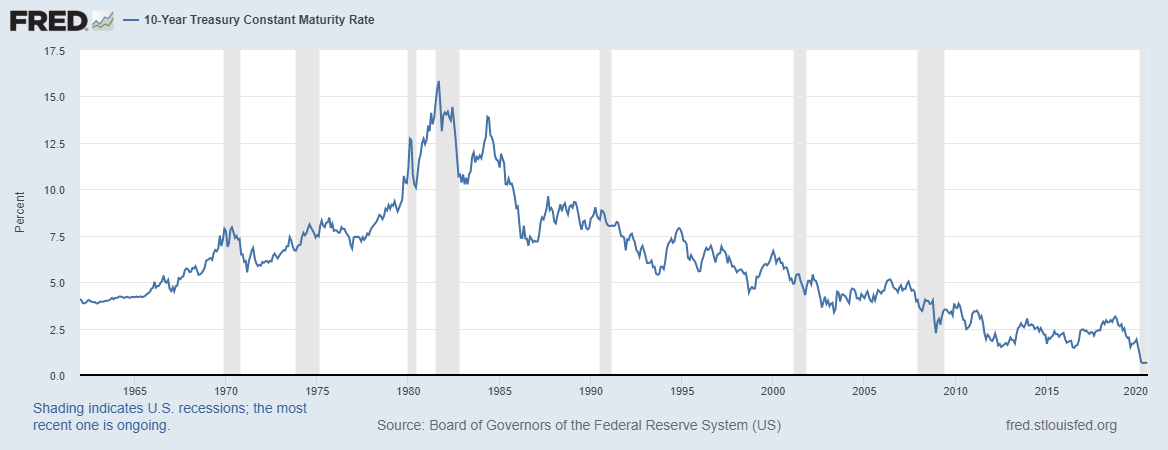AMM 3rd Quarter 2020 Client Letter
Imagine a modern day Rip Van Winkle had imbibed a bit too much on New Year’s Eve 2019 and fell into a long 6 month slumber. He awakens to a strange new world. People will not shake his hand when he greats them, but opt for an “elbow bump” instead. Everyone outside is wearing masks. His favorite restaurant is permanently closed. Luckily, the internet still works, and he is brought up to speed quickly on the global Covid-19 pandemic.
The news is grim. The human cost is nearing 150,000 deaths. Large chunks of the economy remain closed or on life- support. School is out – indefinitely. Consumer confidence and small business optimism has plunged. GDP is expected to contract by nearly 30%. He learns that more than 22 million jobs were lost between February and April, nearly 3 times the job loss from the entire 2008/09 financial crisis. Expecting the worst, he looks at the stock market and is shocked to see prices not far from the New Year’s Eve close.
There has been no shortage of media coverage on the “disconnect” between the market and the economy described above. Our modern day Rip Van Winkle asks, “how is it possible that stocks be up when there is so much economic carnage.” He makes the mistake of assuming that the market is a data-based mechanism that takes in hard economic data and spits out prices that reflect this data. This is a logical but wrong view of how markets work.
In his 2011 book “The Most Important Thing”, Investor Howard Marks has described this kind of simple view as “first level thinking”:
First-level thinking is simplistic and superficial, and just about everyone can do it (a bad sign for anything involving an aflempt at superiority). All the first-level thinker needs is an opinion about the future, as in, “The outlook for the company is favorable, meaning the stock will go up.” First level thinking says, “It’s a good company, let’s buy the stock.” Second level thinking says, “It’s a good company, but everyone thinks it’s a great company, and it’s not. So the stock’s overrated and overpriced; let’s sell.”
According to Marks, second level thinking is “deep, complex and convoluted,” a very apt description of investing! In the investing world, what may seem contradictory to first level thinkers may actually be more consistent with reality. Second level analysis may help us bridge the divide between the bear economy and the bull market. Consider the following:
- The Future: Markets do not focus on pricing present conditions, but rather on discounting potential future outcomes. After a severe sell-off earlier in the year, the Federal Reserve announced the most aggressive monetary easing policy in history. Markets went from discounting a depression as the likely outcome (S&P down 34% in 23 trading days) to a short-lived recession backed by unlimited monetary easing and a sprinkle of vaccine hope (S&P up 38% from the March low through the end of June).
- Liquidity: The Fed easing described above resulted in a massive injection of liquidity. Add to this a fiscal stimulus program that sent the savings rate skyrocketing. With everyone at home, there was little to spend money on. A recovering market may have sensed pent up demand strongly asserting itself in the back half of the year.
- “There is no Alternative”: The Fed’s aggressive policy stance included near zero interest rates. Treasury yields plummeted shortly thereafter and have remained near all-time lows (Exhibit A). For investors seeking some kind of return, a palpable sense of TINA (there is no alternative to stocks) took hold.
All of the above (a forward looking market, high levels of liquidity and little competition to stocks) created a bullish environment for stocks against an otherwise dismal economic backdrop. Reading the first level headlines of any publication would have Rip Van Winkle pressing the sell button. But, underneath the headlines lurked a second level analysis in line with current market reality.
Importantly, none of the above is to assume that we have blue skies ahead. This is an ex-post analysis of what has driven the market to this point. We think it helps to explain the dichotomy between the difficult economic backdrop and the more bullish market environment.
Mid-year Review and Market Outlook
Through 6/30/2020, domestic stocks (S7P 500) declined -3.1%, developed international stocks (EAFE) declined -11.3%, and emerging market stocks (EM) declined -9.8%. Bonds (Bar Cap Agg Idx) increased 8.7%, commodities decreased -21.4%, and gold increased 16.1%. We have updated our asset class return chart below.
Second level analysis aside, the rapid pace of the market rebound in Q2 has been surprising. While markets may be looking forward to pent up demand and the ongoing effects of Fed stimulus, they do not appear to be discounting the risks associated with a prolonged economic downturn, burgeoning cold war with China, political/tax uncertainty in an election year and social upheaval. Such is the case with markets, which are “all knowing” in the immediate sense as they represent the “wisdom of the crowd.” But the crowd can be myopic too. Longer term concerns can fester and be ignored for years, only to rise to the surface all at once when the market decides they are relevant.
In our Q2 letter we postulated that the fledgling bear market that started on March 10th would, like most bear markets, follow the path of duration, frustration and capitulation. The bear market turned out to be both the quickest (peak to trough) and shortest (20% above trough) in history. There was effectively no duration, but certainly some frustration and capitulation occurred during the exodus from stocks that occurred near the March lows.
Looking beneath the surface there may be some opportunities in those assets left behind in the recent run-up. The themes that have worked in 2020 are also the most expensive: Large over Small, Domestic over International, and Growth over Value. Interestingly all three of these themes are extensions of longer cycle themes that have mostly played out since the global financial crisis of ‘08/09.
We do not know the date or timing of a shift in these themes, but like all trends we expect them to reverse at some point. Rather than completely eschew the themes that are currently working, we have begun making slow shifts in to some of the “underperforming” themes. Beginning in 2019 we began incorporating a value oriented exchange traded fund in Asset Allocation oriented portfolios*. In Q2 of this year we added direct small-cap company exposure for the first time in many years, and increased mid-cap exposure. We have continued to invest in both developed and emerging market international equities throughout this cycle, as these markets appear priced for more attractive forward returns relative to their domestic counterparts.
At the sector level we have also initiated a small position in energy stocks in late April. While the S&P 500 ended June off 3% year-to-date, the S&P Energy sector was down 37% over the same time frame. The energy sector has been dealing with a trifecta of headwinds in lower demand (recession), a glut of supply and a longer-term shift away from fossil fuels. We believe the first two concerns will be self-correcting and have created an opportunity in this space.
In fixed income we have continued to keep exposures mostly short-term and of high quality. We are concerned with high yield fixed income. While the Fed has initiated corporate bond purchase facilities to help support the functioning of these markets, we remain unconvinced that they will completely backstop all over-levered companies. If there is a wave of defaults we’d prefer minimal exposure. While the high quality, short-term bond exposure provides limited levels of absolute return, we continue to view these positions as critical for our balanced and more conservative portfolio strategies. We think these positions should be considered not just for the return profile, but also as a source of volatility control and liquidity in client portfolios.
*Individual accounts will vary based on a client’s stated objectives, risk tolerance and time frame. We manage several different portfolio strategies, so not every client has exposure to the securities, asset classes or investment strategies discussed above. In addition to growth and/or income oriented asset allocation strategies, we also manage more concentrated equity portfolios that generally carry a higher degree of risk and volatility.
Recently the SEC adopted new rules and forms, including Form CRS. Form CRS is a customer relationship summary which must be provided to clients of Investment Advisors and Broker Dealers. To comply with these new regulations, we have included a copy of our recently filed Form CRS for your records.
Should you have any questions about your investment account(s) and personal financial plans, or if there have been any recent changes to your investment and/or retirement objectives, please do not hesitate to contact our office to speak with one of us at your convenience.
As always, we thank you for entrusting AMM to help you achieve your investment and retirement objectives.






